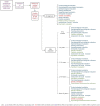An overview of the trajectory of Brazilian individuals with 22q11.2 deletion syndrome until diagnosis
- PMID: 35189940
- PMCID: PMC8862281
- DOI: 10.1186/s13023-022-02225-9
An overview of the trajectory of Brazilian individuals with 22q11.2 deletion syndrome until diagnosis
Abstract
Background: 22q11.2 deletion syndrome (22q11.2DS) is a rare disease with an important characteristic-clinical heterogeneity. The diversity of organs, regions, and systems of the body that can be affected requires periodic updating of health professionals so that they can recognize these clinical signs as belonging to 22q11.2DS. Updated professionals are equally important for the appropriate and timely clinical management of individuals with a positive diagnosis. In this context, this article aimed to map and analyze the access to healthcare for individuals with 22q11.2DS until the moment of diagnosis.
Results: We analyzed the clinical data of 111 individuals with 22q11.2DS registered in the Brazilian Database on Craniofacial Anomalies (BDCA) from 2008 to 2020. In this study, individuals were diagnosed at a median age of 9 years (mean = 9.7 years). Before the genetic investigation, they accessed 68.75% of the internationally recommended evaluations available at BDCA. Recurrent 22q11.2DS clinical manifestations such as delayed neuropsychomotor development, lip and/or palate defects, cardiac malformation and/or hematological/immunological alteration co-occurred in at least 72.06% of individuals. Cardiac malformation was the only clinical alteration that lowered the median diagnostic age, corresponding to 6.5 years of age with a cardiac malformation versus 11 years of age without one (p = 0.0006).
Conclusions: In Brazil, 22q11.2 DS is under-recognized, and early diagnosis and management of affected individuals are still a distant reality. In this sense, 22q11.2 DS suspicion followed by the elimination of obstacles for its diagnosis confirmation is essential to increase life expectancy and improve the quality of life of these individuals in Brazil.
Keywords: 22q11.2 Deletion syndrome; Access to health care; Clinical management; DiGeorge syndrome; Healthcare utilization; Multidisciplinary care age of diagnosis; Public health.
© 2022. The Author(s).
Conflict of interest statement
The authors declare that they have no competing interests.
Figures
References
-
- Gil-da-Silva-Lopes V, Lustosa-Mendes E, Monteiro F. Guia de manejo clínico para pacientes com Síndrome de Deleção 22q11.2. Campinas; 2014. p. 1–29.
Publication types
MeSH terms
LinkOut - more resources
Full Text Sources
Medical


